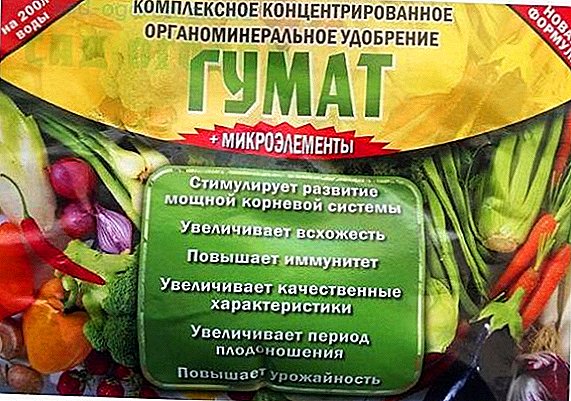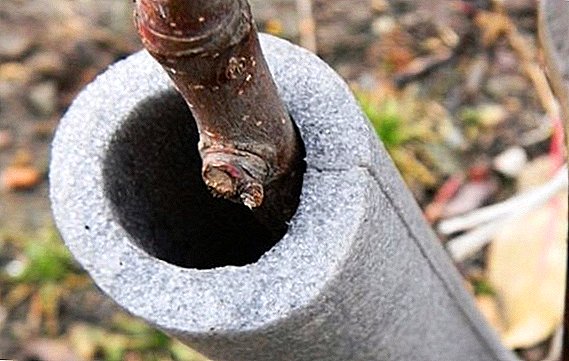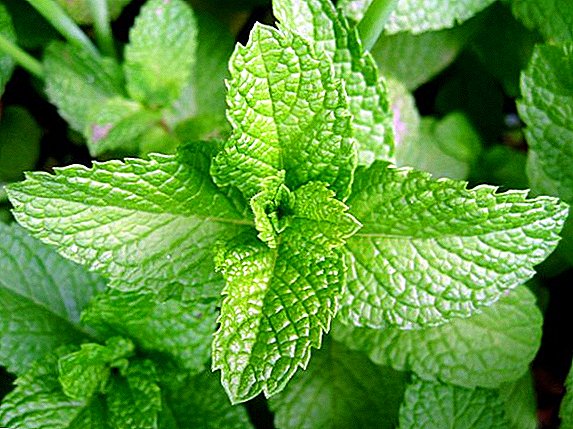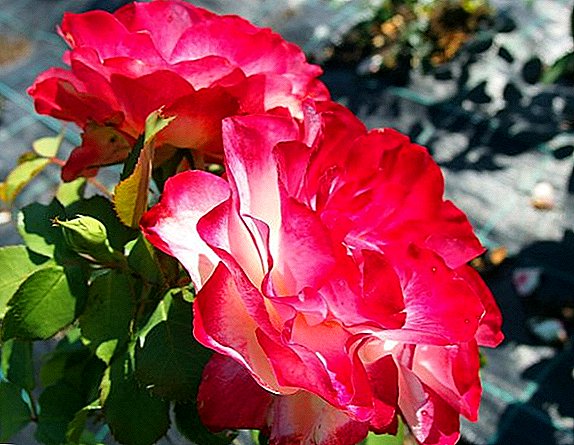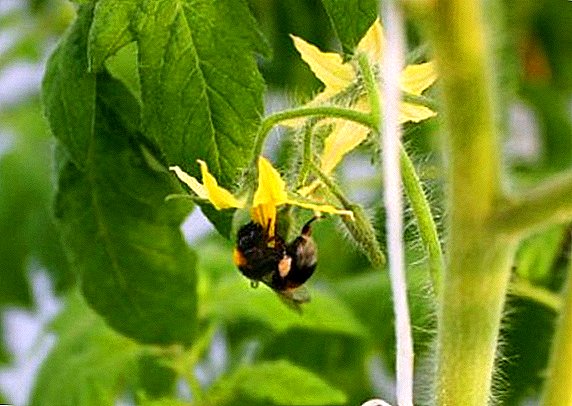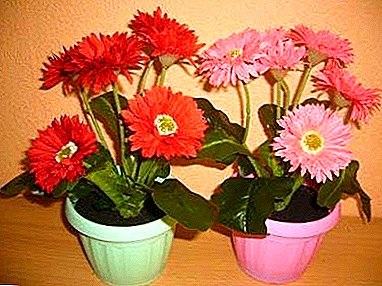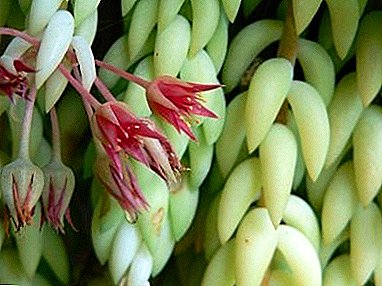
Sedum or otherwise Sedum - These are succulents from the Tolstyankov family.
In our country, more often, Sedums are called "squeeze", "feverish grass" or "hernial grass".
There are over 500 species worldwide. But among those that grow at home the most famous is Morgan's Sigh.
Description
Stems at this representative not thickbut rather long, they can grow up to one meter, very densely covered with leaves. Most often, all the stems grow from the root, branch extremely rarely.
 The leaves of the crepunum are very original - fleshy, thick at the base, and pointed to the top, resembling fangs or claws in shape.
The leaves of the crepunum are very original - fleshy, thick at the base, and pointed to the top, resembling fangs or claws in shape.
The leaves are adjacent along the entire stem, as they do not have petioles.
Color may be green or gray-green., and slightly with a bluish tinge. Feel smooth with a slight waxy coating that is a sunburn shield.
Plant by itself very fragileEven slightly hitting, the leaves immediately fall. New on the site of the fallen will not grow.
Because of its appearance Morgan's Sigh also often called "hare cabbage".
Flowers in hernia grass located at the very tip of the hanging stem on very long pedicels, collected in florets of up to 10 pieces each.
The color is bright pink or red sometimes violet. The buds are tulip-shaped, when opened - a five-pointed star with bright yellow stamens inside.
A photo
Morgan's Sigh:


Sedum Morgana:


Care
Morgan's Sedum - a capricious and demanding plant, but with proper care at home, its spectacularly descending stems will become a real decoration of any interior.
Pot
When buying, choose a small plant without external damage, the leaves should be smooth, without wrinkles. Immediately purchase capacity.
It is desirable not to take a big pot. The root system of the squeaks is small, so it will fit 10 - 12 cm in diameter, shallow.
Landing
 Planting or further transplantation is best done in the spring, once every 2 to 3 years, due to slow growth.
Planting or further transplantation is best done in the spring, once every 2 to 3 years, due to slow growth.
Mix for landing do as follows: in equal proportions mix turfy and hardwood, sand and high-moor peat, a little crushed charcoal.
You can purchase ready ground for cacti. At the bottom of the pot must fill a layer of drainage, use expanded clay or broken bricks.
Top dressing
Fertilizing is carried out with conventional fertilizer for succulents. and cacti once a month, preferably with a low nitrogen content, except in winter.
Lighting and heat
Since Sedum came to us from hot countries, it grows best in a sunny place, a window facing south or southeast will do.
Not afraid of direct sunlight. Perfectly transfers temperature from +23 to +30 degrees. In the summer you can take out to fresh air.
With improper lighting leaves stumble and fall off.
Air humidity
Rabbit cabbage grows well with moderate humidity, but it also carries more dry air, so it is often not necessary to spray a plant.
Just to freshen up and knock off the dust.
Watering
 Feverish grass is a succulent, which means it tends to accumulate moisture inside and water such a plant with caution.
Feverish grass is a succulent, which means it tends to accumulate moisture inside and water such a plant with caution.
A small drought is not terrible, and a large amount of water will cause the root system to rot.
From watering to watering, make sure that the earth lump dries well 1.5 cm deep.
If Morgan’s sedum is completely filled with the pot, just check the pie with a toothpick to avoid touching the plant.
Water is better to use settled room temperature..
Bloom
This type of succulent is referred to as decorative foliage.
It can occur only in fairly old plants and only in a very hot summer, with proper care and maintenance during the rest period.
Preparing for the winter
An important period in the life of a plant is a rest period.. To start in the fall we reduce watering.
Earthen ball should dry at least 3 cm in depth, 1 time per two weeks. Since November, do not make fertilizer.
Then we move the stonecrop in a cool room at a temperature of +8 to +13 degrees, but the lighting should be sufficient, otherwise the shoots will stretch.
You can make an electric light. Such the rest period from stonecrop lasts from November to March.
Breeding
Morgan's chin breeds very easily.
The first method is part of the stem.. To do this, one of the long shoots is carefully cut into several small pieces of about 5 to 7 cm.
 You can put in the water, and you can dry a little and put immediately in the ground. The optimum temperature for rooting will be +16 - +20 degrees.
You can put in the water, and you can dry a little and put immediately in the ground. The optimum temperature for rooting will be +16 - +20 degrees.
The second - leaf cuttings. Take all the fallen claws, dry and put in the ground. Cover with glass or bag, air regularly.
With this method, the plant will increase the green mass longer. In both cases, watering should be moderate.
Diseases and pests
- Stalk stripping or pulling. The reason is a lack of light, mechanical damage.
- Root rot. May occur from abundant watering or cold winter. Watering pruning, and in spring the plant cheren.
- Leaves dry out - not enough moisture.
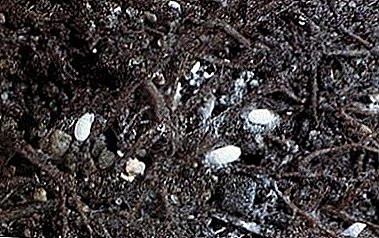 Nematodes - small roundworms. Treatment is the treatment of a plant with household soap solutions, and in the case of an extensive lesion, treatment with actellic.
Nematodes - small roundworms. Treatment is the treatment of a plant with household soap solutions, and in the case of an extensive lesion, treatment with actellic.- Rootbird - affects the root system, the plant quickly fades.
The plant should be transplanted by removing the damaged roots, and the rest should be treated with tobacco or infusion of a pharmacy calendula.
Generally Sedum Morgana lives excellently for 6 years, then the plant should be renewed.
AT traditional medicine juice this plant used as a healing agent for wounds and burns, but if there are children at home, it is better to hang it higher, in case of getting into the stomach it can cause upset and vomiting.


 Nematodes - small roundworms. Treatment is the treatment of a plant with household soap solutions, and in the case of an extensive lesion, treatment with actellic.
Nematodes - small roundworms. Treatment is the treatment of a plant with household soap solutions, and in the case of an extensive lesion, treatment with actellic.